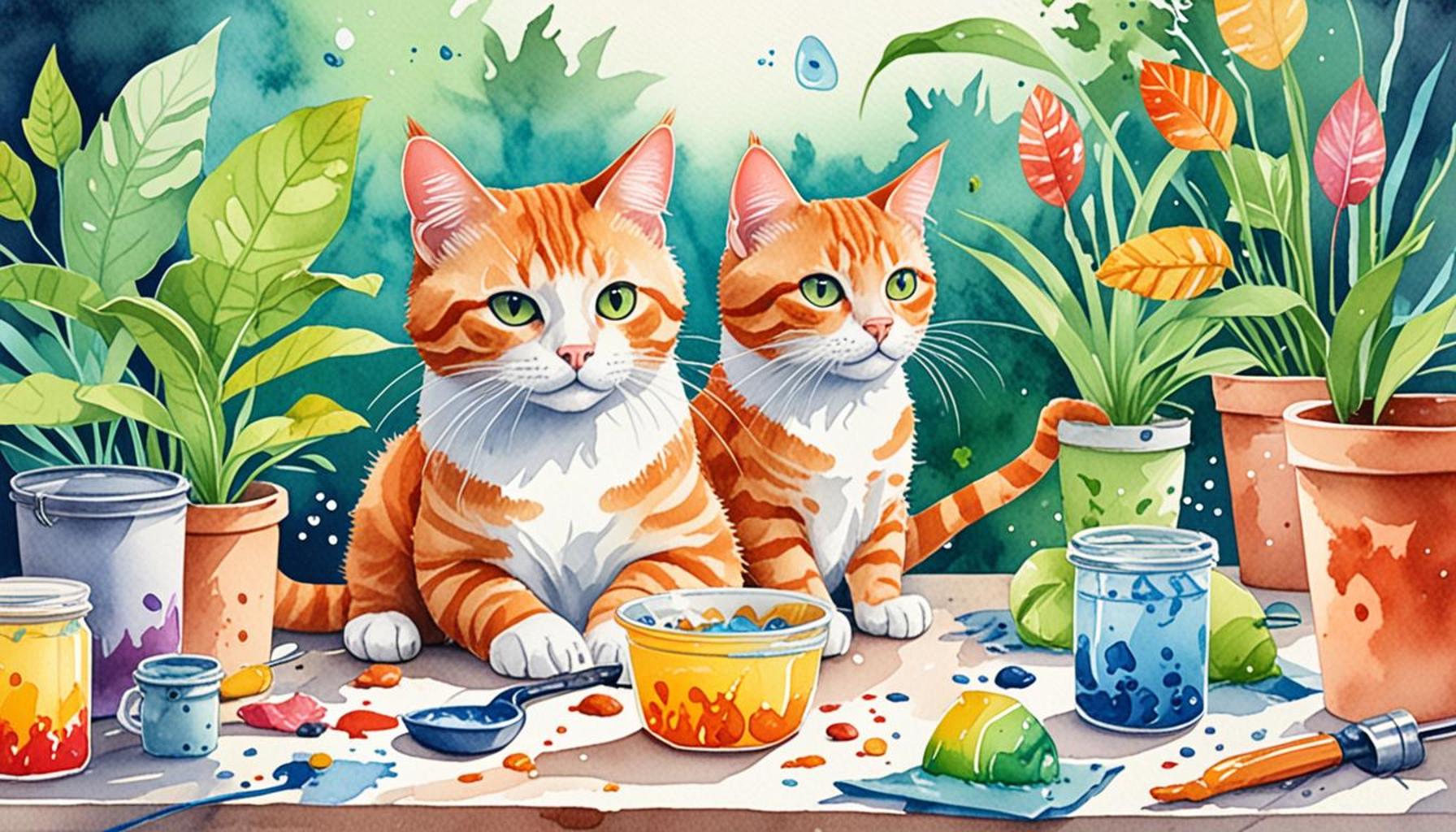Environmental Enrichment Techniques for Cats: Stimulating Natural Behavior

Understanding Environmental Enrichment for Cats
Creating a fulfilling environment for your cat is crucial for their well-being. Environmental enrichment techniques stimulate your feline friend’s natural behaviors, promoting physical and mental health. By offering a variety of activities and experiences, you can cater to their instinctual needs.
Why Environmental Enrichment Matters
Cats are natural hunters and explorers, driven by instincts that have evolved over thousands of years. Left unaddressed, these instincts can lead to boredom and stress, manifesting in destructive behavior like scratching furniture, excessive meowing, or even aggression towards other pets. Therefore, providing an engaging environment is not just a luxury; it’s essential for their health.
For instance, reducing stress is one of the primary advantages of environmental enrichment. Activities such as playing with interactive toys or engaging in games that mimic hunting can alleviate anxiety. A stressed cat may withdraw from social interaction or may even refuse to eat, which can lead to health issues. Creating a cozy nook with their favorite blanket and a window with a view of wildlife can significantly enhance their comfort and security.
Encouraging physical activity is another key factor. Cats require routine exercise to maintain a healthy weight and support vital organ functions. Introducing cat trees, scratching posts, and laser pointers can keep them moving. Consider setting up an obstacle course or engaging them in fetch games. These playful activities not only keep your feline friend physically fit but also strengthen the bond between pet and owner.
Additionally, enhancing mental stimulation is vital for cognitive functions. Puzzle feeders that require cats to figure out how to release the food are a perfect example of mental enrichment. Playtime that involves hiding treats around the house encourages problem-solving and promotes mental agility, making it not just fun but beneficial for their overall mind health.

Incorporating elements of nature into your home, such as cat-safe plants or bird feeders visible from a window, can further enrich their environment. These small changes can provide endless opportunities for exploration and entertainment. The landscape of environmental enrichment is abundant and can range from simple toys to complex setups. By dedicating time and resources to enhance your cat’s environment, you not only allow them to express their natural behaviors but also contribute to a happy, healthy, and harmonious home.
DON’T MISS: Click here to discover the importance of hydration for your pet
Engaging Your Cat Through Play and Exploration
One of the most effective environmental enrichment techniques for cats revolves around play. Cats engage in interactive games that not only address their instinctual behavior but also provide them an outlet for their pent-up energy. Understanding the importance of play is fundamental in creating an environment that caters to a cat’s natural instincts.
Playtime should mimic the activities cats would engage in their natural habitat. This can include stalking, pouncing, and hunting movements. In a home setting, this can be accomplished with a range of toys and activities such as:
- Feather Wands: These toys allow cats to engage in their predatory instincts as they chase and bat at the moving feathers.
- Laser Pointers: A favorite among many felines, laser pointers encourage cats to run and chase, providing excellent exercise while honing their hunting skills.
- Small Balls and Mice: Toy mice or balls that mimic small prey animals can stimulate a cat’s desire to pounce and capture.
- Interactive Puzzle Toys: These add an element of challenge, forcing cats to think critically to access treats hidden inside.
In addition to toys, creating a space that facilitates exploration is crucial for environmental enrichment. Cat trees and shelves provide vertical spaces where cats can climb, climb, and observe their surroundings from a higher vantage point, reminiscent of their wild counterparts who typically seek higher ground to keep an eye out for potential prey or predators.
Moreover, enriching your cat’s environment can extend beyond physical items. The introduction of cat-safe plants, such as catnip or cat grass, can provide sensory stimulation. Not only do these plants offer olfactory engagement, but they can also encourage natural behaviors like chewing and rolling—actions that are instinctive for many cats. This type of sensory interaction can amplify happiness and reduce stress for indoor cats by allowing them to express their natural behaviors in a safe setting.
Another interesting technique in enhancing a cat’s environment is to create a window perch or install a bird feeder outside. Cats are naturally curious and enjoy watching birds and small animals. By providing an unobstructed view of the outside world, you can satisfy their innate desire to observe and investigate their surroundings.
Through a combination of physical play, interactive toys, and sensory experiences, you can effectively enrich your cat’s life. Engaging in these environmental enrichment techniques encourages healthy behaviors associated with a cat’s instincts, ultimately leading to a happier and more fulfilled feline companion.
| Category | Advantages |
|---|---|
| Physical Stimulation | Encourages exercise, helping to maintain a healthy weight and muscle tone. |
| Cognitive Engagement | Promotes mental health by challenging your cat with puzzles and interactive toys. |
| Natural Hunting Behaviors | Lets cats express their innate instincts, reducing boredom and stress. |
| Social Interaction | Enhances bonding with human companions, leading to a happier home environment. |
Incorporating environmental enrichment techniques not only supports your cat’s physical health but also nurtures their psychological well-being. By providing a variety of stimulating activities, you can engage their natural behaviors that might otherwise go unfulfilled in a typical indoor setting. In this way, your home becomes a dynamic playground, offering both fun and meaningful interactions. Additionally, activities that simulate hunting or exploring can greatly reduce unwanted behaviors that stem from boredom. Exploring more options, such as cat trees, interactive feeds, and sensory experiences, will further enhance the enrichment of your cat’s life. By recognizing these natural instincts and providing opportunities to express them, you’re fostering a more balanced and satisfied feline companion. Each technique is an essential part of responsible pet ownership, promising not only a happier cat but also a more harmonious relationship between you and your furry friend.
LEARN MORE: Click here to find out what foods to avoid for your furry friend
Creating a Multi-Sensory Environment
Further enhancing your cat’s living space involves the use of multi-sensory environmental enrichment techniques that cater to a cat’s entire array of senses—sight, smell, hearing, taste, and touch. Engaging multiple senses not only helps alleviate boredom but also promotes overall well-being, ensuring that your feline friend leads a fulfilling life indoors.
Sound can be an often-overlooked element in environmental enrichment. Consider adding nature sounds or ambient animal noises that can stimulate your cat’s curiosity. There are even specialized albums and playlists with bird calls or rustling leaves designed specifically for cats, creating an immersive environment that mimics their natural habitat. The gentle sounds provide both comfort and stimulation, offering an opportunity for mental engagement while your cat is lounging or playing.
Next is the aspect of smell. Cats have a highly developed sense of smell, and introducing new scents can provide an exciting challenge for them. Apart from catnip, which has been known to elicit playful behavior in many cats, consider incorporating other aromatic plants such as valerian root or silver vine. These natural scents can engage cats intensely, prompting them to roll, scratch, or simply investigate. Utilizing scents can fulfill those essential exploratory behaviors that indoor cats may miss out on.
Another effective strategy for stimulating your cat’s taste and engaging their natural foraging behaviors is by using puzzle feeders. These items require your cat to work for their food, making mealtime a fun and stimulating experience. They encourage problem-solving and mimic the hunting and gathering of prey. Not only do puzzle feeders entertain your cat, but they can also regulate their food intake, pairing mental stimulation with healthy eating habits.
Furthermore, playing with textures can also enhance the sense of touch. Providing a variety of scratching surfaces—such as cardboard, sisal, and carpeting—can not only deter your cat from scratching furniture but also give them an outlet for their natural instincts to scratch and stretch. Consider incorporating textured toys filled with catnip or crinkly materials that can enhance their tactile experience, adding layers of enjoyment to their play.
Finally, social enrichment plays a pivotal role in a cat’s overall happiness. Engaging with your cat through training sessions can foster a bond and stimulate their minds. Simple commands or tricks can provide a rewarding experience, further satisfying their inclination for interactive play. Additionally, if your household permits, consider introducing a second cat or pet, providing opportunities for social interaction and companionship, which is vital for a naturally social species.
The most successful environmental enrichment techniques for cats involve a harmonious blend of physical, sensory, and social elements, creating a stimulating environment. By understanding and implementing these strategies, you can significantly enhance your cat’s living space, promoting their mental and emotional well-being.
DISCOVER MORE: Click here to learn about pet allergies
Conclusion
Incorporating environmental enrichment techniques into your cat’s life is essential for fostering both their physical and mental health. As we have explored, creating a stimulating indoor environment is not merely about entertainment; it plays a crucial role in mimicking natural behaviors that may be absent in confined spaces. From the allure of multi-sensory stimulation involving soundscapes, intriguing scents, to engaging textures, each aspect contributes significantly to your cat’s well-being.
By integrating puzzle feeders and textured surfaces, you not only challenge your cat’s natural foraging instincts but also create opportunities for play that are both rewarding and healthy. The addition of interactive elements, such as training sessions and the possibility of feline companions, fosters social interactions that resonate deeply with a cat’s instinctual behavior. These techniques work seamlessly together to fulfill your cat’s innate needs, making life indoors vibrant and engaging.
As responsible cat owners, it is our duty to recognize that our pets thrive when their environments reflect their natural instincts. Consider experimenting with different enrichment techniques to discover what delights your unique feline companion. Such practices not only elevate your cat’s quality of life but also build a stronger bond between you and your pet. Investing time in environmental enrichment is an investment in your cat’s happiness, health, and overall harmony within your home. For a more fulfilling feline experience, embrace the potential of these strategies and watch your cat flourish.


